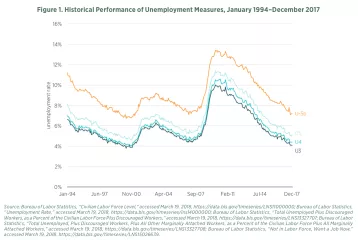- | Government Spending Government Spending
- | Expert Commentary Expert Commentary
- |
BLS Jobs Numbers Analysis, April 2018
The Bureau of Labor Statistics (BLS) jobs report released today illustrates a labor market that continues to strengthen. Unemployment is at the lowest rate since December 2000 while the number of layoffs is at a 45-year low.
Employment
- Total nonfarm payroll employment increased by 164,000 jobs in April (and jobs growth estimates for February and March were revised upward by 30,000 jobs).
- The labor force participation rate dropped slightly to 62.8 percent.
- The headline unemployment rate (U-3) fell by 0.2 percentage points to 3.9 percent.
Some commentators have expressed concern that the lower unemployment rate is the result of decreasing labor force participation, but the simultaneous decline in other unemployment measures suggests that these fears are unwarranted.
- The discouraged worker unemployment rate (U-4) fell by 0.1 percentage points to 4.2 percent.
- The marginally attached unemployment rate (U-5) fell by 0.2 percentage points to 4.7 percent.
- The comprehensive jobless rate (U-5b) fell by 0.1 percentage points to 6.9 percent.
The comprehensive jobless rate offers a benchmark to compare the official unemployment statistics reported by the BLS. It’s the most holistic measure of unemployment, counting everyone who doesn’t have a job and says that they want to work. This expansive definition of “joblessness” includes people who fall through the cracks in the BLS’s measurements, like frustrated job-seekers who haven’t actively looked for work in the last year and students who weren’t immediately able to take a job.
The fact that other unemployment measures declined in conjunction with headline unemployment rate suggests that the decline in labor force participation is not artificially causing a similar decline in unemployment—it’s more likely that the lower rate of labor force participation reflects the increasing retirement of baby boomers.
Wages
Similarly, many commentators have expressed surprise that wage growth—which was 2.6 percent over the previous 12 months—has not been stronger in an increasingly tight labor market. While this reaction is understandable, it misses a couple key points:
- Wage growth is only important in relation to the goods and services that the increased wages can buy. A better perspective would incorporate how fast wages are rising relative to the cost of living. After all, if both wages and inflation rise by 5% the average worker has not gained anything.
- Furthermore, because increasing wages themselves lead to higher production costs—and therefore rising inflation—we should not be myopically rooting for higher wages.
Because inflation over the previous 12 months was 2.4 percent, the average worker has come out slightly ahead.
In addition, the most-often reported wage growth number is the average wage growth, which smears out more relevant industry and regional variation in income changes. For example, while average private industry hourly wages only rose by 2.6 percent over the last 12 months, hourly wages in “leisure and hospitality” and “other services” sectors rose by 3.1 percent, while the retail trade average wage rose by 3.5 percent. Similarly, hourly wages rose by 3.9 percent in construction and by 3.2 percent in the nondurable goods manufacturing.
Lastly, the number of part-time workers who would prefer to work full time has been steadily decreasing (falling by 34,000 last month), but there are still nearly 5 million—19 percent of part-time workers—who would work more if they could. It’s possible that these workers, as well as those who are re-emerging from long-term joblessness, are gradually accommodating the increased demand for labor, thereby moderating the growth in wages.


